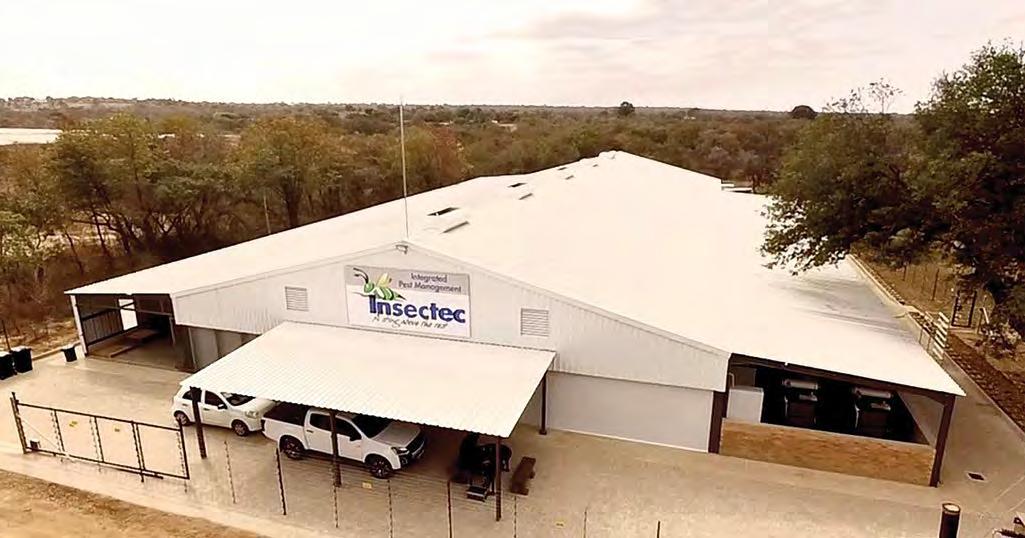
7 minute read
Fighting the mealybug
Founded in 2015, Insectec, a local company in Limpopo, has expanded from a small laboratory in Tzaneen to becoming a leader in the production of natural enemies for use in integrated pest management systems on farms in South Africa.
In a joint venture, three farming enterprises in the Letsitele area, namely Mahela Group, Komati Fruit Group and Laeveld Citrus, joined forces with Insectec and completed a stateof-the-art Insectary situated in Letsitele.
This new insect rearing facility has recently been opened in Letsitele and boasts the latest technology and a local research and development team that enables them to address the specific needs of their clients.
Cutting-edge technology has been installed in the new insectary that will allow the company to produce large numbers of healthy, high-quality, beneficial insects for use in agriculture. The new facility will also host a research and development department.
“Although we might be a bit cheeky to claim it, we believe that we have the largest insectary in the Southern hemisphere,” says Karel van Heerden, Chief Executive Officer. “Our mission is to produce integrated and sustainable solutions for pest management that contribute to a healthier and more productive agricultural systems.
“Investment in innovation is the foundation for sustainable solutions in agriculture. Our business is based on proper research, and the development department is focused on finding new innovative methods and solutions to address pest management problems. In addition, we develop products for local conditions in conjunction with our clients,” he added.
The Insectary is run by Hannah Otto, Director and Production Manager, whose expertise in insect breeding under South African conditions is well-known. The facility focuses on the production and application of beneficial organisms used in biological pest control and integrated pest management programmes. Insects will be massed-produced to support integrated pest management (IPM) programmes of citrus and grape farmers locally and abroad.
The use of natural enemies in most cases is incorporated into the integrated pest management programmes of producers. IPM is a system of managing pests in agricultural crops through a combination of biological, cultural, physical and chemical control methods.
IPM is an effective and environmentally sensitive approach to pest management that relies on a combination of commonsense practices, says Andrew Bennett, Agricultural Consultant.
“IPM programmes are based on information regarding the life cycles of pests and their interaction with the environment. This information, in combination with available pest control methods, is then used to manage pest damage to crops by the most economical means with the least possible hazard to people and the environment,” Bennet explains.
“In order to breed the natural enemies, we have to breed the prey. At this stage, the only prey we breed is mealybug, Hemiptere: Pseudococcidae, an economically important pest. Mealybugs are soft-bodied scale insects and extremely difficult to control chemically. The use of natural enemies is considered as the best alternative means of control,” Otto says.
All the natural enemies that are produced at Insectec occur naturally in South Africa and are therefore adapted to most regions in the country.
Four natural enemies for mealybug are bred. Each of these TO PAGE 32


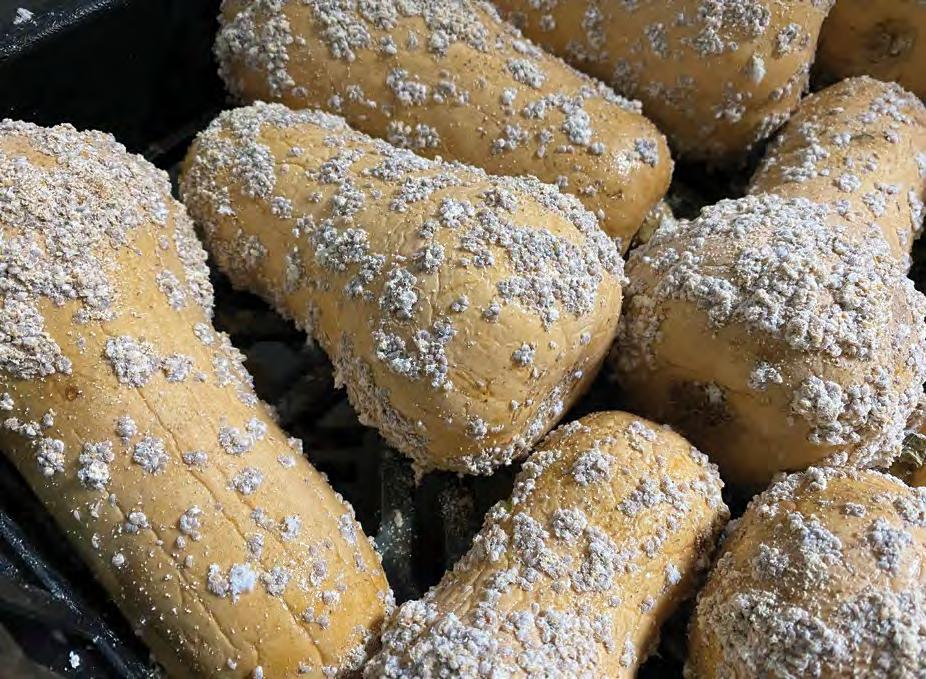

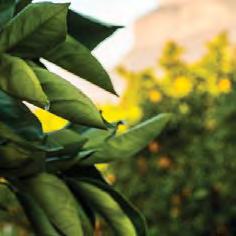

Butternuts are produced on contract for Insectec for the sole purpose of breeding mealybugs. These butternuts must be disease-free without traces of chemical pest control products and are washed before used as hosts for breeding mealybugs.
Fighting the mealybug
FROM PAGE 31
targets a different life stage of the mealybug and can be used to complement each other to control different mealybug species. Some of the natural enemies, however, are host specific and only target certain mealybug species.
“The ladybeetle Crypto-tec, Cryptolaemus montrouzieri, targets all mealybug stages and most mealybug species and is compatible with a wide range of crops. The other predatory beetle that we produce, Neph-tech, Nephus kamburovi, however, is a tiny beetle that only feeds on mealybug eggs and early life stage of the mealybug,” she explains.
In addition to the two predatory beetles, they also produce two parasitic wasps, Ana-tec, Anagyrus vladimiri, and Cocci-tec, Coccidoxenoides perminutus. They are used together in situations where the citrus mealybug is the dominant species in the orchard as they complement each other by targeting different life stages of the mealybug.
Insectec’s packaging is designed in such a manner to keep the insects safe as well as to make it easy for release into an orchard. Although the packaging for the various products looks similar, each product contains different amounts of insects according to the crop as well as environmental conditions.
A typical biological control programme to manage a light infestation of citrus mealybug in a citrus orchard will entail the simultaneous release of about 1 000 Ana-tec and 15 000 Coccitec wasps per hectare.
“Each situation is different, and the dosages are dependent on many factors, such as region, climate, mealybug species, infestation level and life span of the pest at that particular moment,” Otto says. The breeding quantities for each of the natural enemies for a particular season are based on planned releases as well as historical data of releases during past seasons. Weather conditions can also play a role.
Normally the predators are not released in the winter months in an area that is known for cold winters, as their growth and activity slowdown in the colder months. The best time of day to release beneficial insects into a cropping system is early in the morning or late afternoon when the temperatures are mild. Different techniques are employed for the various predatory insects.
“The effectiveness of using natural enemies to control pests is impossible to ignore and therefore have become an integral part of integrated pest management control programmes throughout the world,” Karel says.
Consumers are increasingly demanding more sustainably produced food. Driven by the con-
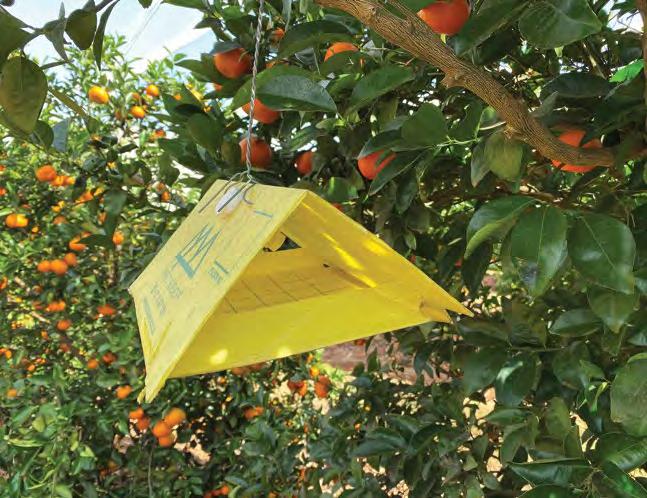
Insect monitoring forms an important part of integrated pest management programmes. It is crucial to monitor for pests and identify them accurately so that appropriate control actions can be taken. The use of insect traps is one of the ways to monitor insect prevalence in an orchard.
Continuous monitoring remains the cornerstone of an integrated pest management programme regardless of the season.

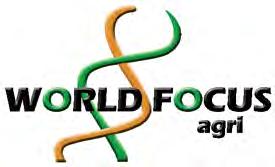
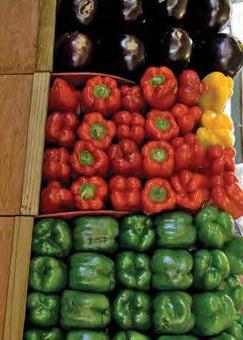
cept of sustainable agriculture and to minimise the impact they have on the environment, producers are also becoming more conscious of the pest control methods they apply on their farms and are increasingly starting to implement IPM systems on their farms.
“Biological pest control forms the cornerstone of our Integrated Pest Management strategy at Mahela and focuses on the long-term prevention and management of pests. We introduced biological pest control in fruit production as part of an integrated pest management strategy to reduce the use and impact of pesticides on the environment and biodiversity,” says Eddie Vorster, Director Citrus production at Mahela Group.
In the past farmers producing fruit in monoculture systems heavily relied on chemicals only to produce quality and pest and disease-free fruit. It is widely accepted however, now that, in terms of sustainability, this is not an option.
Although fruit producers will still employ chemical control measures, at about 3 to 4 months prior to the harvesting season, they need to find alternative ways to control pests and diseases due to maximum residue level restrictions on chemical usage. This is where the true value of biological pest control in an integrated pest management system, and the role this new facility can play, comes to the fore.
“To be a successful grower, one needs to understand the balance nature provides,” says Karlien Grobler, Group Quality Manager at Komati Fruit Group. According to Karlien, the incorporation of biological measures remains a challenge, especially without a continuous supply of beneficial insects.
“At Komati, we plan the chemical interventions we apply for thrips, red scale, mealybug, and blackspot timeously and carefully to get the control we require with as little as possible disruption of the natural balance. When the risk period for damage ceases, we will top up our beneficial complex with biological insects supplied by Insectec, to sustain us through the remainder of the season.”
“Protecting citrus and other fruit production against attacks from pest insects is an essential part of production management, and this is where Insectec will be able to assist our farmers. Our services are available to all farmers,” says Van Heerden.

Energy management using Innovative Technology
UNLEASH THE GREEN REVOLUTION!
World Focus Agri products act as an organic growth stimulant throughout the plants life cycle.
ORGANIC GROWTH STIMULANT
ORGANIC LEAF NUTRITION
MICRONIZED LIME GYPSUM
LAND CORRECTORS
World Focus Agri concentrates on developing and producing organic as well as biologic growth stimulants and enhancers via root and leaf applicants. Our ambitions, change the conventional view of plant protection to plant health via its biology.










